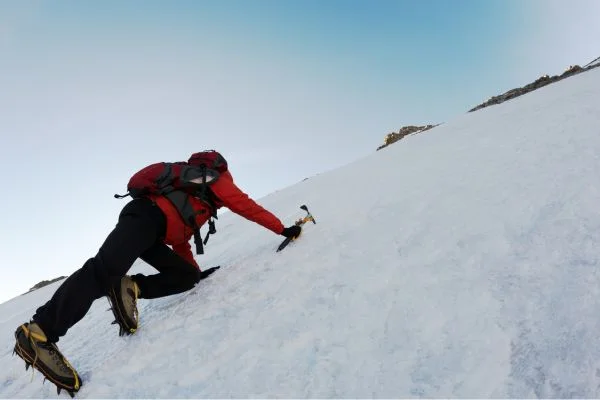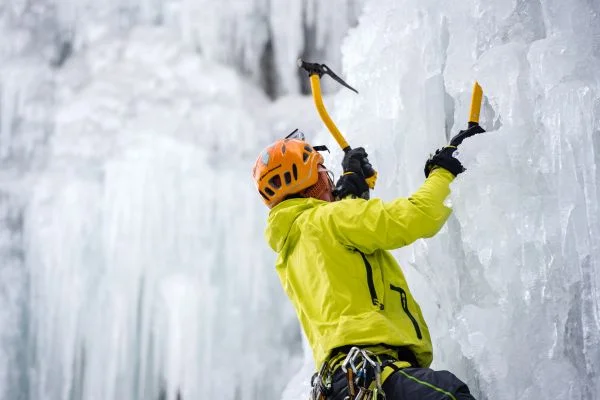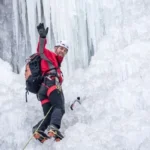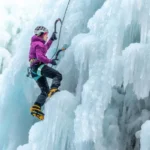Are you looking for an exciting new adventure that will push your limits and help you explore the great outdoors? Look no further than ice climbing! Ice climbing is a thrilling way to experience nature while honing your physical and mental skills. But where do you start? Read on for our guide on How to Start Ice Climbing.
How to Start Ice Climbing | Pro Tips

Choose Your Gear
The most important thing about ice climbing has the right gear. Not only will it help keep you safe while you climb—but it will also make your experience much more enjoyable. Some of the essential items you need include:
• Helmet – This will protect your head from rockfall or falling ice chunks. Get one that fits comfortably and won’t move around while climbing.
• Crampons – These metal spikes attach to your boots so you can grip the ice better. The size and shape of crampons depend on the terrain you plan on tackling, so do some research before purchasing one.
• Harness – A harness should fit snugly around your waist and legs for optimum comfort and safety during your climb. Look for adjustable straps to make adjustments as needed during different climbs.
• Ice axe – An essential tool for any climber, an ice axe helps dig into the ice for stability and balance while ascending or descending a route. Choose one that feels comfortable in your hands and is easy to maneuver when making moves like swings or stabs into the wall of ice.
• Rope – A rope is used as an anchor between two climbers or as a belay system when someone leads a route up an icy face or wall. Make sure to purchase one rated for both single-pitch aid climbing and multi-pitch traditional routes.
Finding a Partner
Ice climbing is safer with a partner since they can provide support if one person falls or slips. Find someone with experience in the sport and learn from them, or join a local climbing club or gym that offers classes for beginners.
Taking courses offered by mountaineering organizations like the American Mountain Guides Association (AMGA) is also essential.
This will give you an understanding of best practices for safety and instruction on different techniques used in ice climbing, such as belaying, rappelling, and building anchors.
Also Read: How To Train For Ice Climbing?
Techniques to Learn
Once you’ve gathered your equipment and found someone to climb with, it’s time to hone your skills! Start by learning about different grips—such as the pick-axe grip—and how to properly use your tools to ascend up the wall safely and efficiently.
You should also familiarize yourself with different stances (e.g., front-pointing) and how to recognize potential dangers before attempting any climb.
Finally, practice using only one hand at a time while scaling so that if one hand slips, the other hand can catch it in time. With enough practice, these techniques will become second nature!
Find an Experienced Guide
If this is your first-time ice climbing, it’s always best to find someone with prior experience who can show you the ropes (literally!).
Find a trusted guide who knows their way around a mountain; they’ll be able to spot potential hazards before they become dangerous and provide valuable advice on how to tackle challenging climbs. They may even be able to recommend some less-challenging routes if you are starting.
Prepare Physically
Ice climbing requires intense physical effort; it demands strength, agility, balance, and endurance. So before heading out on any climbs, ensure that your body is prepared by doing exercises such as pull-ups, sit-ups, and squats — this will help build up strength and stamina to handle whatever challenges await!
It’s also important to stay hydrated before and during climbs; bring plenty of water with you, so your body doesn’t become dehydrated while scaling icy heights.
Also Read: Is Ice Climbing Dangerous?
Safety Tips
Before going out on any climb, it’s essential to be aware of some safety tips:
• Always check weather conditions – Ice climbing can be dangerous during bad weather conditions such as high winds or heavy snowfall, so always check what conditions are expected before heading out on a climb.
• Research routes beforehand – Knowing what terrain lies ahead can help prepare you mentally and physically for a successful ascent up an icy face or wall. Before attempting it yourself, you should also familiarize yourself with common handholds, footholds, and other technical aspects of each route.
• Have a partner – Having someone with you who knows how to operate necessary gear, such as rope systems safely, can make all the difference between success or disaster while climbing in icy conditions.
• Know how to self-arrest – In case of emergency slips or tumbles while glissading down an icy slope (sliding downhill using crampons), learning how to self-arrest may be necessary to save yourself from further harm or injury due to being dragged along by gravity itself!
Also Read: What Do You Need For Ice Climbing?
Conclusion
Now you know, How To Start Ice Climbing? Ice climbing is an exhilarating activity that promises adventure around every corner. To get started safely, prepare physically with regular exercise routines, choose quality gear from trusted sources, and find experienced guides who know their way around the mountain. With a bit of preparation, anyone can embark on an unforgettable journey into ice climbing!



